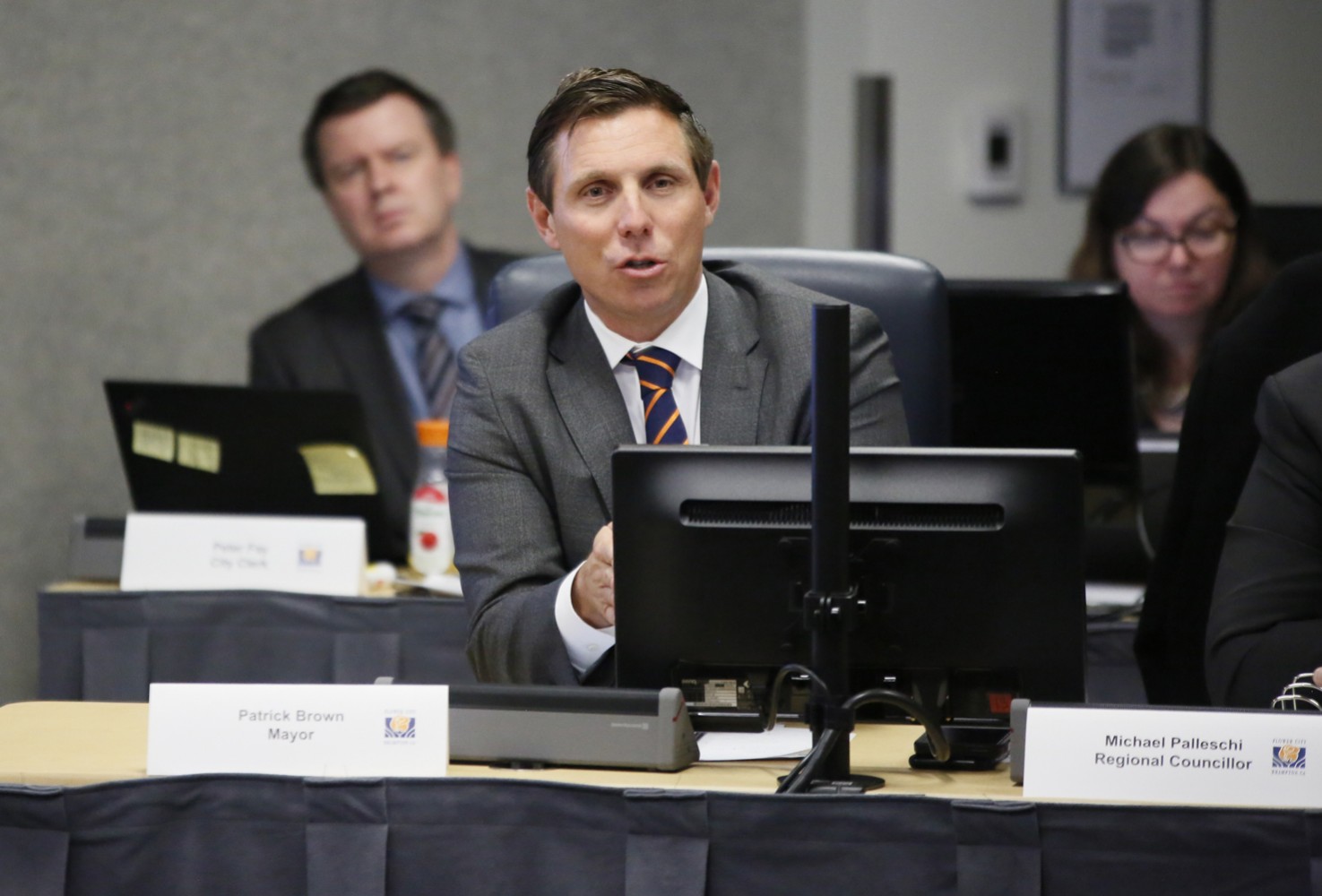
Brown gets city-budget proposal he wanted: Ford-style cuts rather than planning for the future
The City of Brampton’s 2020 budget offers another breath of fresh air for residents of a city who have been grappling with years of above inflation rate tax increases. However, in order to achieve a proposed small budget increase, the City is making decisions that could have potentially dangerous consequences for the future.
In order to pull down city spending, nearly $284 million in capital projects have been either pushed to next year or delayed even further. The impacts of these delays are compounded after 2019 saw similar project delays as a result of the tax freeze desired by councillors — and pushed by Mayor Patrick Brown, a promise he made during his 2018 mayoral campaign.
With the city’s aging infrastructure and mounting growth pressures, these types of decisions, while attractive in the short-term, could result in drastic consequences down the line as needed replacements and repairs continue to be put off, leading to, in the best case scenario, more crumbling potholed roads, and in the worst case, a catastrophic failure of a key piece of City-owned infrastructure.
It’s something Councillor Jeff Bowman is very cognizant of going into budget deliberations this week. During discussions on the 2019 budget, Bowman made it known that he was not in favour of the tax freeze, and questioned the impacts such a low increase would have on the future of the city. He has the same questions in 2020.
“If we keep having these really, really low budgets, it will catch up with us at some point,” Bowman says. “I do not believe in zero percent budgets, we have to maintain the same inflationary rate as any other household or business.”
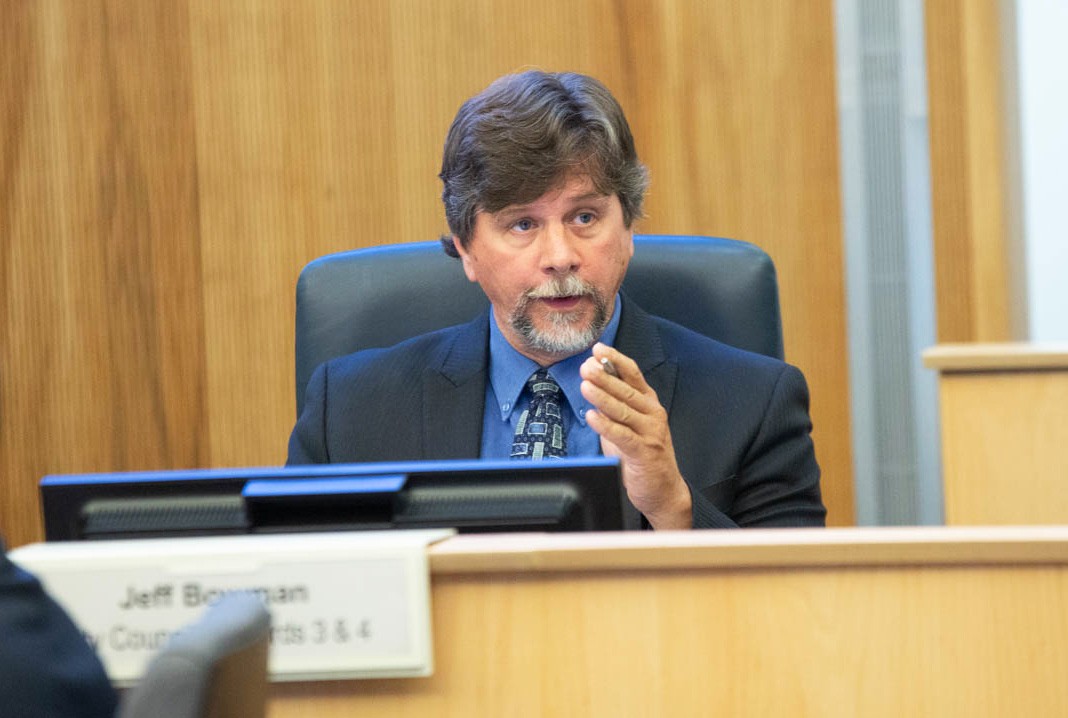
Councillor Jeff Bowman
There’s no denying the proposed budget, which will be debated by the 11 members of council starting this week before they approve the final numbers for 2020 and set the property tax bill, will win favour among many residents. If approved by councillors it would see Bramptonians paying an additional $27 over 2019 on the city’s portion of the tax bill. When combined with the Region of Peel portion and the province’s education portion of the budget, it results in approximately $91 more for the average home assessed at $538,000.
However, these additional tax dollars may not be going toward the things the city desperately needs.
The main cause for the small proposed increase in the 2020 budget is the city’s growing operating budget, rising by 6.7 percent to $756.4 million. While the operating budget is used to pay for things like utilities, building maintenance and other day-to-day expenses, the largest chunk, nearly 57 percent, goes toward salaries, wages and benefits for city hall staff. Because 66 percent of the operating budget is funded through property taxes, it means more residential tax dollars are going toward paying the salaries of Brampton employees.
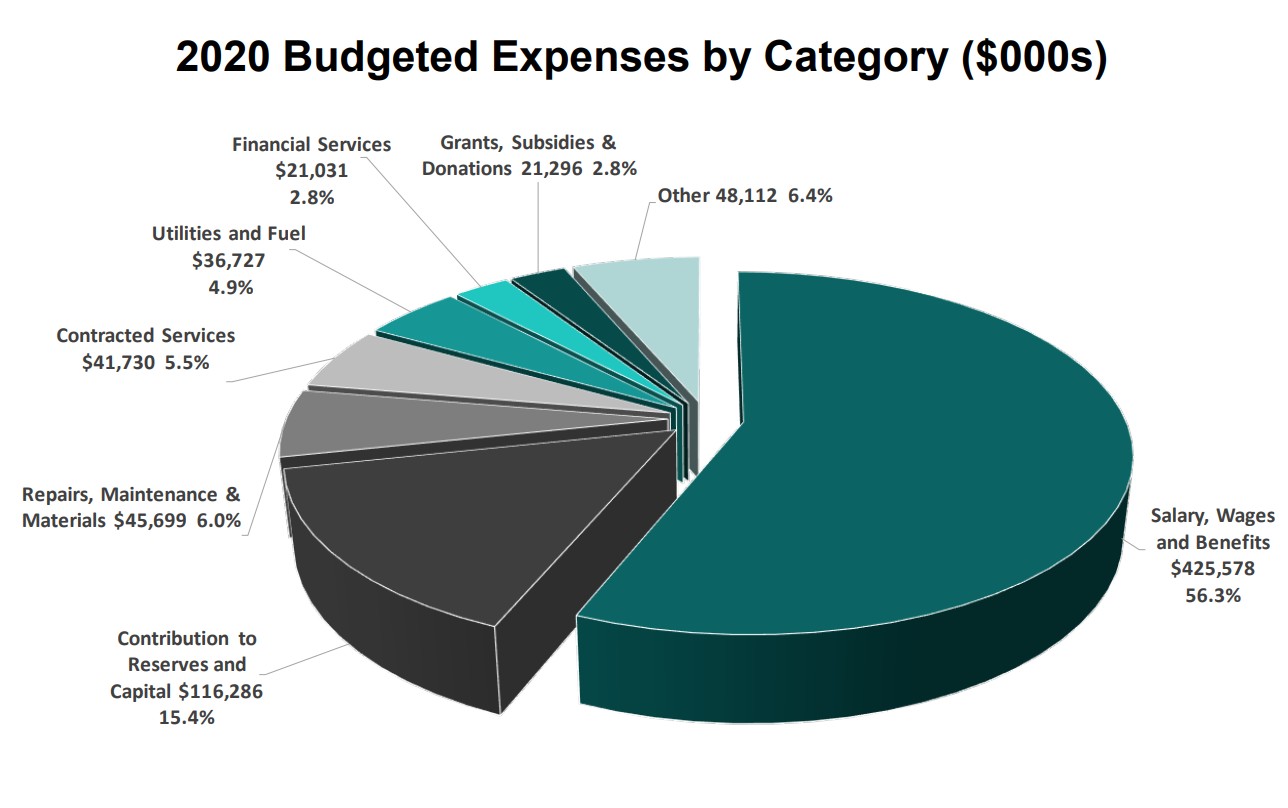
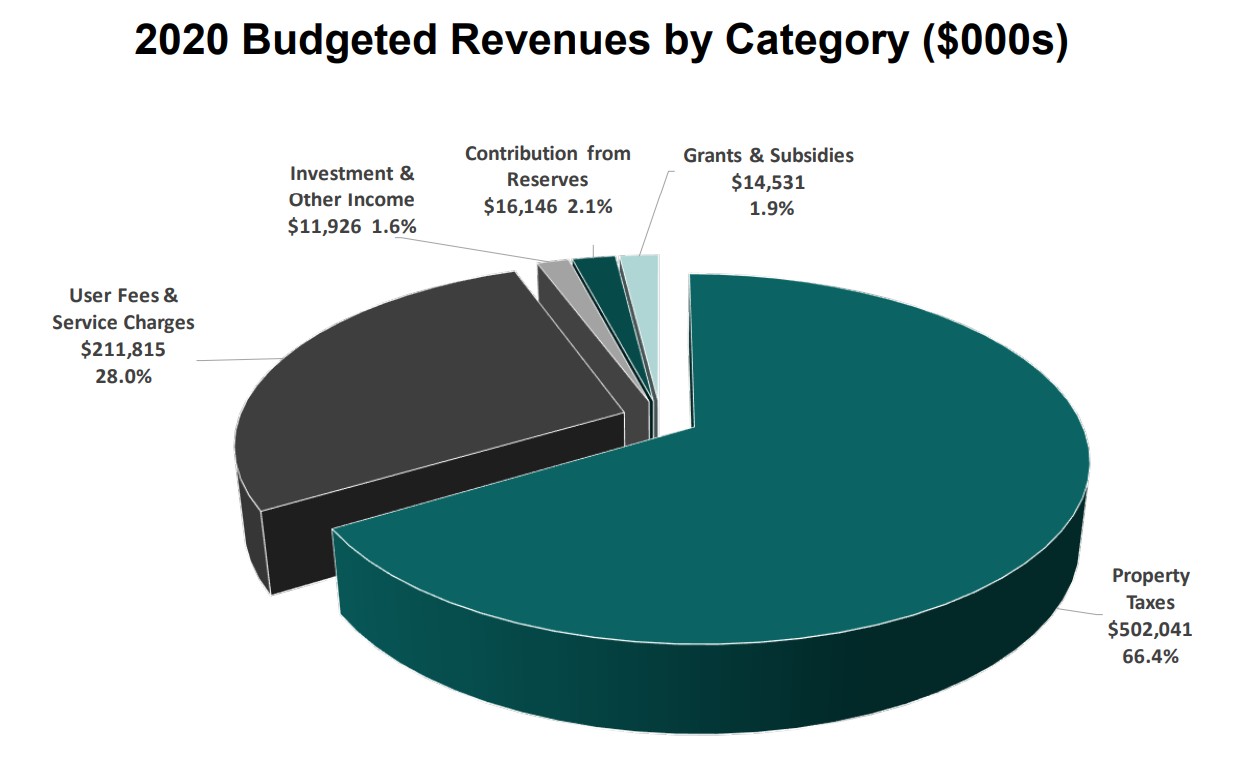
Two pie charts highlight the impact City of Brampton salary and wage increases have on residential tax bills. The largest chunk of the City's operating budget, around 56 percent, goes toward salaries and wages (top), while the biggest source of revenue for that budget is property taxes, accounting for 66.4 percent (bottom).
The 3 percent increase for salaries and wages, an additional $12.4 million, comes despite a cut to the number of new staff proposed for 2020. Originally, Brampton planned to see 102 new full-time staff added to the city’s complement, but the new proposal only includes 45 new staff, most of them in the development and community services departments.
Increasing salary costs have been a thorn in the side of the city for years. A 2015 analysis of the city’s finances by former Ontario auditor general Jim McCarter found staffing costs at the city were not sustainable. At the time, almost all of Brampton’s revenue gains from rapid growth were being eaten up by salaries and wages for municipal employees, while service costs were rising steadily and property tax rates had increased dramatically. McCarter found that while the city was taking in 120 percent more property taxes than 10 years earlier, 94 percent of that additional revenue was going toward the city’s ballooning payroll.
The City had been mired in spending scandals for years, with former mayor Susan Fennell earning the highest mayoral income in Canada, on top of a taxpayer funded luxury Lincoln Navigator SUV and a 24/7 on-call limousine service that cost local property owners almost $50,000 a year. Her lavish expenses and frequent luxury trips across the country, to Miami Beach where she owned a condo and around the world were paid for by unwitting Brampton taxpayers.
Other senior staff enjoyed lavish perks such as expensive car allowances and trips that included stays at high-end hotels.
It was all part of a city hall culture that displayed a remarkable level of disrespect for taxpayers.
After Fennell was shown the door by voters in a resounding defeat in 2014, there was more bad news, raising the level of anger among residents to new heights.
Under mayor Linda Jeffrey, a shocking internal audit revealed that senior staff during the Fennell years had given themselves and other non-union employees, secret bonus payments totalling $1.25 million, with some of the money handed out as “favouritism” according to the audit.
Jeffrey and other council members at the time voiced their alarm over the level of irresponsible and reckless behaviour among staff who used taxpayer dollars like their own personal piggy banks.
Jeffrey, at the time, stated: “this is at best serious negligence, and at worst corruption.”
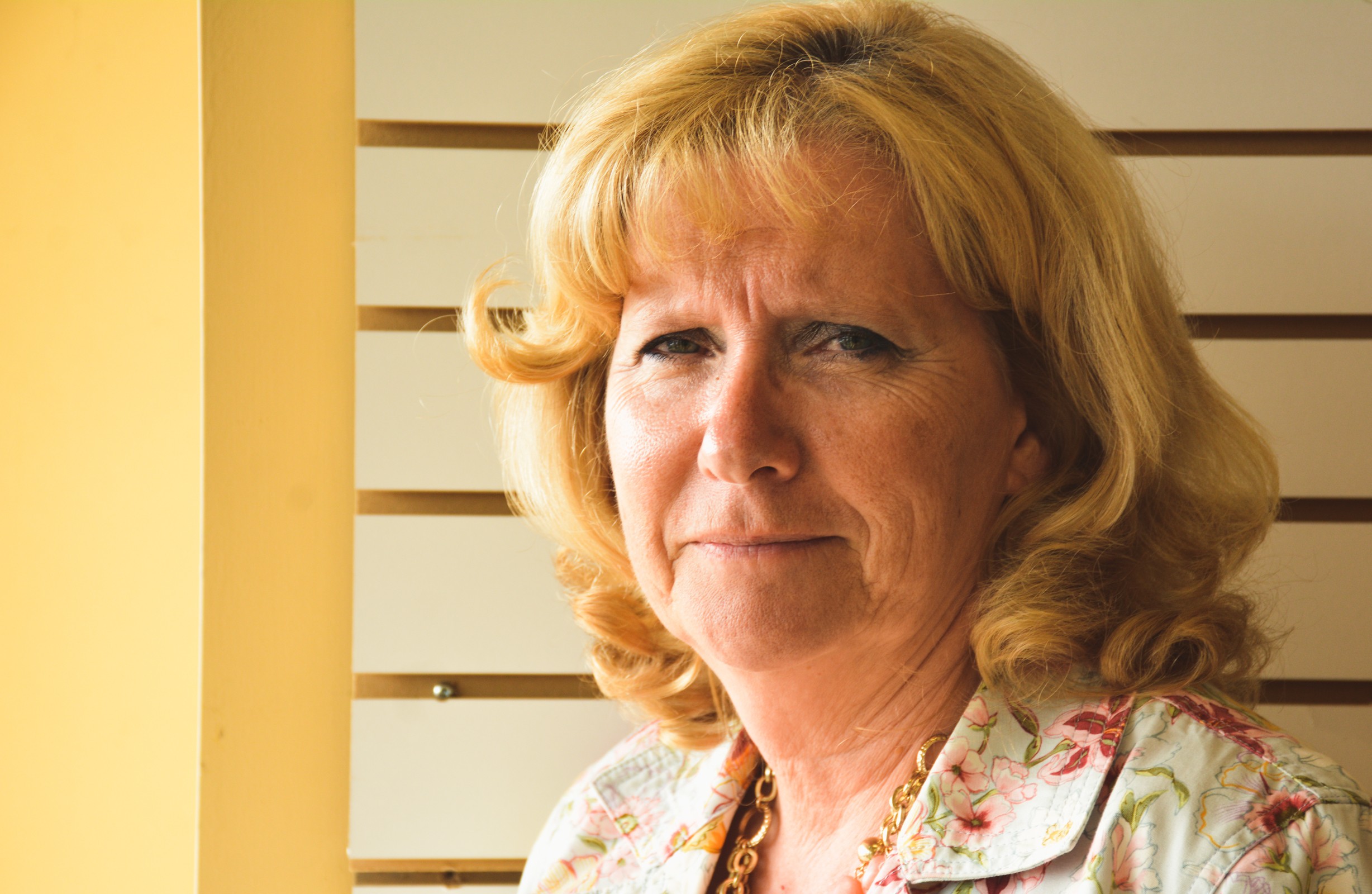
Former Brampton mayor Linda Jeffrey
It remains unclear what the city has done since the revealing McCarter report, which warned that if staffing costs were not reined in, future city projects could be put in jeopardy.
Council and Brown have not heeded the warning, with councillors in the current term approving an extra million dollars for their own staff complement and the mayor expanding the size of his office dramatically, including the addition of positions that spend a large amount of time promoting the media-savvy mayor.
But despite the dramatic cuts to funding for infrastructure needed in the city, while costs for management, council, non-union and union staff keep going up, some councillors are pleased with the priorities in this year’s proposed budget, which include relatively small investments in the city’s post-secondary sector through $5 million over five years to support the Rogers Cybersecure Catalyst, the Ryerson “Innovation District”, and $7.3 million over three years to support Algoma University’s downtown expansion.
“I believe the proposed budget reflects city council’s desire to continue to deliver high-quality streamlined services to our residents while ensuring we’re continuing to find efficiencies. I am pleased there are no service reductions being proposed as part of the 2020 Budget,” says Councillor Martin Medeiros. “As a reminder, Council approved a service review audit of each department, and we continue to challenge staff to ensure residents’ tax dollars are spent wisely and that our proposed 2020 budget is aligned with our term-of-council priorities. During last year’s 2019 budget deliberations we froze Brampton’s taxes for the first time in 20 years. It’s important to keep our property tax increase as low as possible, for example below the rate of inflation, but also ensure it does not compromise the future. As Canada’s ninth largest city, it’s important we position ourselves to be competitive with neighbouring municipalities, create opportunities for growth and attract new business and investment.”
With a strong desire from councillors to keep the tax increases low, and potentially even freeze them again in 2020, it means staff have to keep to a short list of priority items that will receive funding. It’s clear from the operating budget that salaries and wages remain a top priority for city hall, while a glimpse at the gutted capital budget shows what is being pushed aside.
The capital investment for 2020 is being cut by 48 percent from what was originally proposed for the current year in the 2019 projection. These projections are calculated based on services the city needs to provide and the repairs and maintenance needed to keep the city’s assets — community centres, roads, libraries, parks, buses, etc. — in a good state of repair. It’s extremely uncommon to see such a dramatic reduction from the original estimates, which were based on clear priorities set by the staff with intimate knowledge of the city’s infrastructure needs.
It was clear that something was not right when all six council budget meetings set for late last year were suddenly cancelled. With those meetings having long been established, staff would have had preliminary budget proposals ready ahead of the meetings which were cancelled.
Things can change, projections can be altered, but cutting over $200 million in projects initially proposed for 2020 suggests someone demanded any tax increase be kept to a minimum, even if it means cutting key infrastructure projects that will eventually need to be completed.
The city could face a number of legal headaches if it neglects such work, and property owners could face even greater tax hikes if short term relief leads to far greater costs in the future, just like a homeowner who ignores the cost of a minor roof leak to save a little money, then has to pay thousands more when the problem leads to major damage.
The departments hit hardest by the cuts include a $64.3 million reduction in capital works spending, a $161.4 million reduction for building, design and construction projects — the largest being the delay of a crucial $135 million transit maintenance and storage facility — and a $58.2 million reduction to public works spending.
Along with the costly transit facility, other delayed projects include:
- $22 million for the new Howden Recreation Centre has been pushed to 2021
- $8 million for the Mississauga/Embleton Community Centre has been pushed to 2021, causing a subsequent $62 million investment into the facility, initially planned for 2021, to be pushed to 2022
- $4.2 million in land acquisitions through realty services pushed to 2021
- An approximate $520,000 cut to planned bridge repairs
- $8 million reduction in capital works land acquisitions
According to Councillor Medeiros, the reductions are in part due to “stronger revenue growth (volume), user fee rate adjustments and efficiencies through the optimization of service delivery in those particular areas,” he said in an emailed response. It’s unclear how increased revenues would lead to the postponement of projects and cuts to budgets for capital needs.
“Capital projects are reviewed annually to determine project readiness and may also be adjusted to reflect the priorities of Council, proposed capital budgets will reflect these circumstances,” he added.
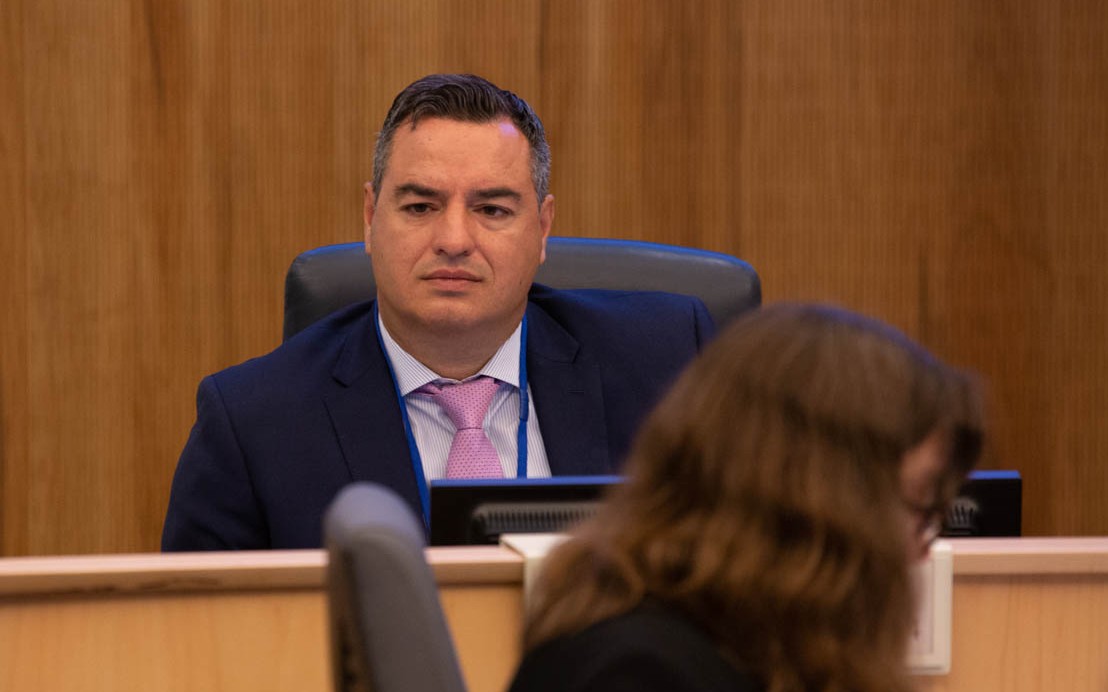
Councillor Martin Medeiros
It’s true that certain projects previously thought to be required at a certain point may no longer be needed. In fact, with climate change altering our typical winter and summer conditions, projections for infrastructure needs are becoming less and less reliable. Warmer winters could mean that roads feel less strain from freeze/thaw cycles, but on the other hand, stormwater infrastructure is now eroding much quicker due to increased rainfall and other pressures related to climate change.
The reasoning by Medeiros does not seem to stand up when faced with investments that the city needs to make, but is simply putting off to alleviate budget pressure.
Ahead of the 2020 budget document being released, Brampton residents already knew the $135 million needed for the city’s transit maintenance and storage facility would not be included in 2020, despite previous plans.
In September 2019, the city announced that the plans for the much-needed additional bus maintenance and storage facility would not be going ahead due to the lack of funding assistance from the federal and provincial governments.
The facility is desperately needed. City documents in 2015 suggested that rising ridership would mean both of the city’s current bus depots — Sandalwood and Clark — would reach capacity by 2021, when Brampton Transit’s ridership was expected to require at least 509 buses. The document called for a third maintenance and storage facility to be built in the northeast part of the city for 2021 and a fourth in the southwest by 2028. Plans for the fourth facility have been shelved altogether.
With the third facility expected to cost between $150 million and $250 million — an amount the city can not swallow on its own — the city would be smart to put aside a portion of the initial planned investment of $135 million for the future project. However, there’s no sign the city will be doing this. The 1 percent transit levy is again being proposed this year — something that will garner the city approximately $4.8 million in 2020 for transit projects — however it’s clear that this extra funding is not enough to meet demand.
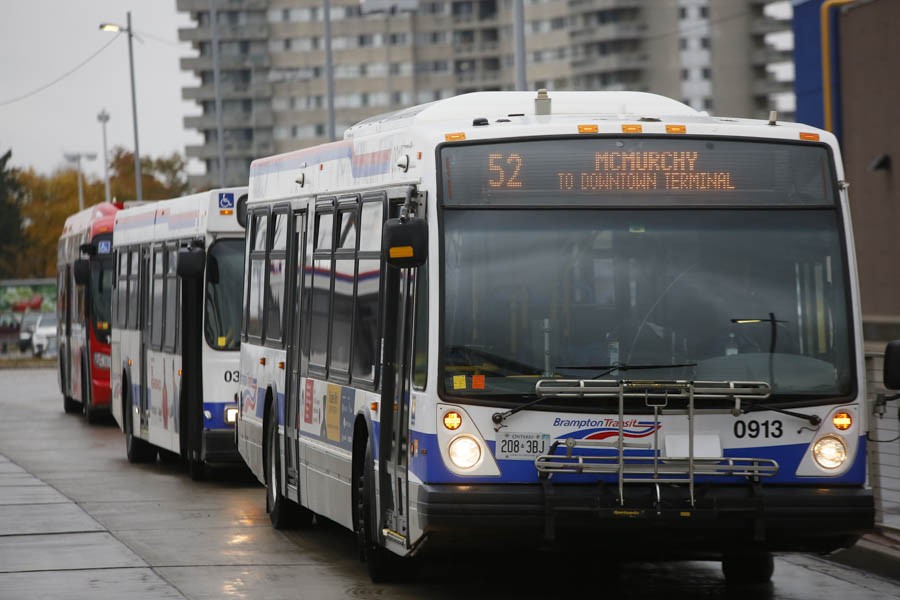
A new maintenance and storage facility for Brampton Transit busses is desperately needed in the city, but a planned $135 million investment that would have been put toward such a facility has been delayed in the 2020 budget.
Currently, the city’s Transit Development Charge Reserve is in deficit and was pushed even further into the red in 2019 when the city took more than $10 million out of the exhausted reserve, pushing it to $48.2 million owing.
The reliance on reserve funds is a tactic to avoid placing that burden on the taxpayers and to keep the tax increases low. It was a strategy used by Mayor Brown’s mentor, former Mississauga mayor Hazel McCallion, who became one of the most popular Canadian municipal leaders thanks to decades of no or near-zero percent tax increases. However, because of her populist approach, the city is now facing a $1.5 billion infrastructure deficit and Mississauga taxpayers have been stuck with massive property bill increases since the legendary mayor retired in 2014.
“I don’t want to see us go down that road,” Bowman says. “I think it’s up to council to look at the structure, to look at the cost, to look at the capital spending and to determine whether that (low tax increase) is going to make a big impact on us in the future.”
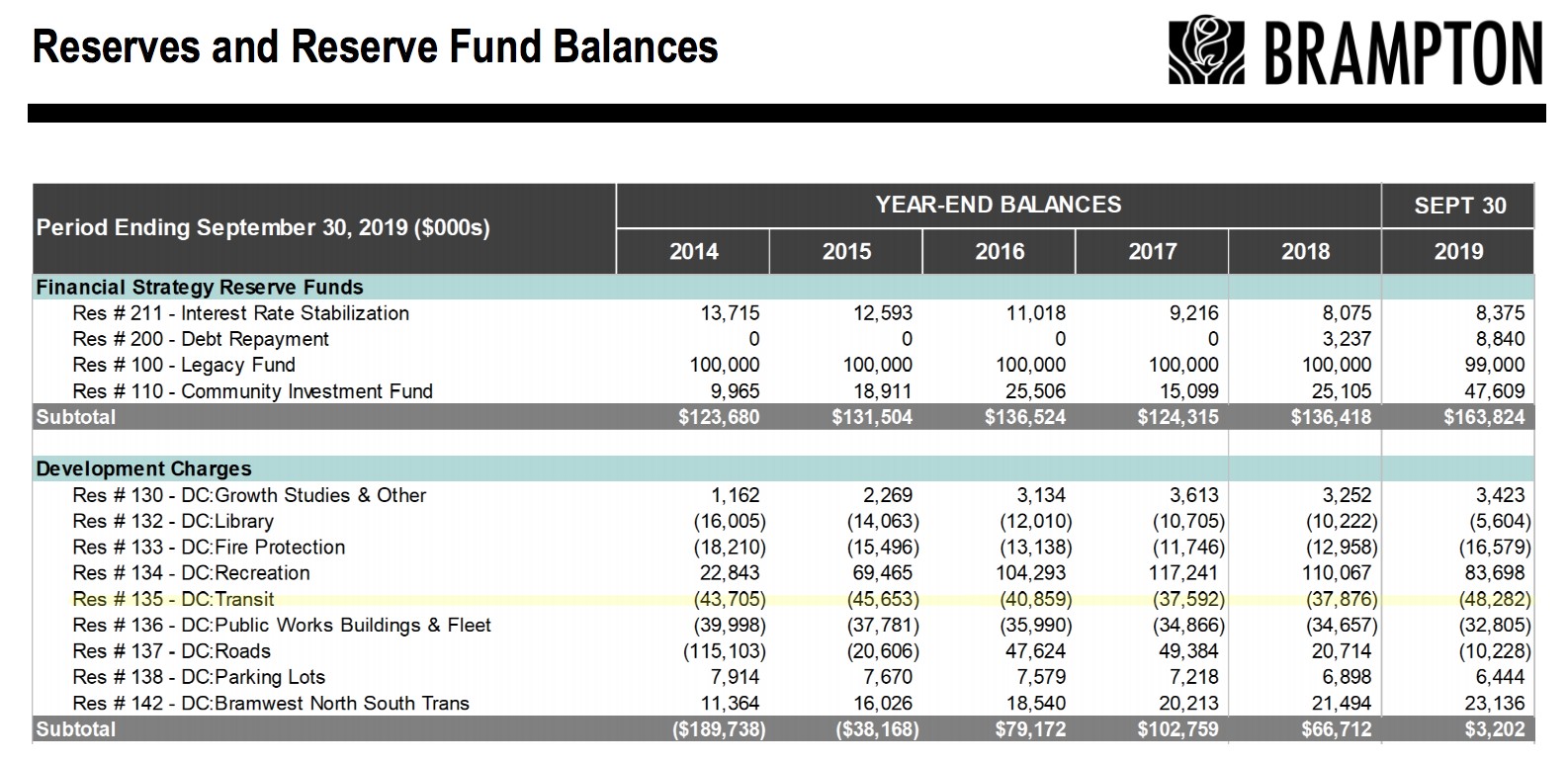
The city's transit reserve (highlighted) was pushed even further into debt in 2019 now showing over $48 million owing.
The lack of proposed investment in 2020 will particularly impact Brampton’s investment toward its core infrastructure — roads, bridges, sidewalks etc. Currently, the city is facing a $364 million infrastructure gap — projects that need to be completed but currently have no funding sources — an increase from the $246 million gap projected in 2019.
To assist in alleviating this gap, the 2020 budget once again proposes a 2 percent infrastructure levy, an additional tax that is expected to garner $9.6 million in 2020. According to the budget document, with the annual levy, the cumulative infrastructure gap is projected to stabilize by 2025 at approximately $629 million.
But there is a major asterisk next to this claim.
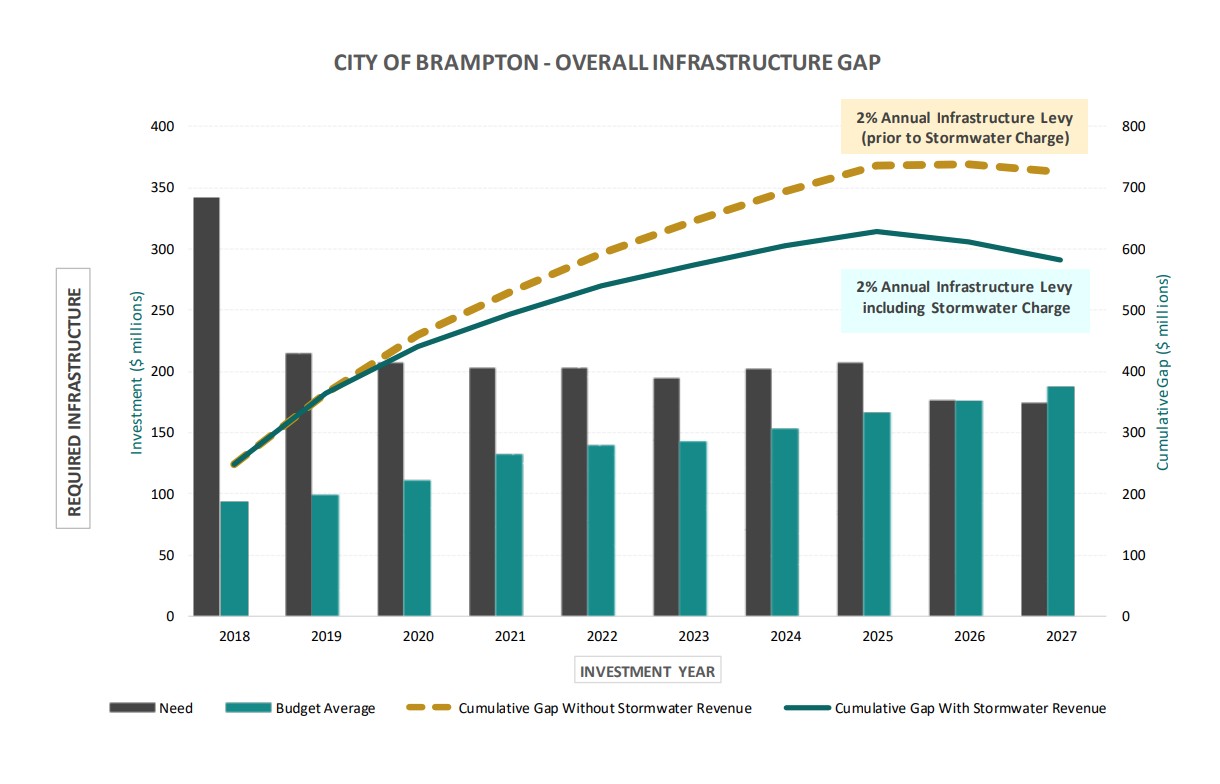
The City of Brampton projects its infrastructure deficit will stabilize in 2025, but that projection may not be completely reliable.
Like any projection, this estimate is not 100 percent reliable. Curiously, it does not take into account any future infrastructure needs or any repairs or replacements needed for those future assets. This is a highly unusual way of projecting the future infrastructure gap, and could be very misleading, attempting to paint a much rosier picture for property owners and potential future private sector partners. The City has explained in the past that as its infrastructure grows, so does the city’s tax base and the anticipated revenues to help maintain this new infrastructure. However, if growth revenues slow, like they did over the last year, with assessment growth anticipated to net the city $5.3 million in additional revenue for 2020, down from $12.8 million in 2019, the city can no longer depend on this source of revenue to keep up with its infrastructure demands.
Additionally, the $364 million infrastructure gap may not capture the full amount of needed repairs. According to the city’s 2018 State of Local Infrastructure report, the majority of the city’s $5.8 billion in assets are listed as in “good” condition and less then 10 percent is considered to be in “poor” or “very poor” condition. How close these descriptions are to reality is uncertain as the data reliability in the report is listed as “low to medium.”
This means that the condition of the asset and its current state or any future repairs needed, is “based upon expert verbal opinion or cursory inspections/ observations,” the document reads. It leaves room for interpretations.
“The findings of this report are subject to limitations within the network. While much of the data gathered to produce this report is based upon reasonable and sufficiently documented procedures, reliance on the expert verbal opinion of City staff was required where gaps in the data existed. These gaps are largely related to the condition rating assessments,” the report reads, meaning that the replacement or repair values in certain circumstances could be different from the amount that is truly required.
The City of Brampton is well aware of such unreliability in projecting future project costs as the delayed Downtown Reimagined plan clearly shows. A collaborative effort between the City of Brampton and the Region of Peel to restore critical pieces of aging infrastructure in the city’s downtown and revitalize the streetscape, the project was put on hold late in 2018 due to a number of unknowns, including costs.
The city budgeted about $30 million in “borrowed financing” for the project, with approximately $2.5 million of that dedicated to the initial EA and planning, which has already been completed. This initial budget appeared to be more than enough to cover the cost of the project estimated at $23 million.
However, jaws hit the floor when the initial bids on the project were received.
Each of the four bids received in response to the region’s tender came in above the city’s budgeted amount, ranging from $55 million to $73 million. Under the joint contract with the region, the city would be solely responsible for between $36 million and $45 million of that total, depending on which bidder was selected.
Although the revitalization was approved years ago and it's well known the city's downtown infrastructure work is desperately needed, it's another project that has been kicked down the road by Mayor Brown, and is again absent from this year's budget. It's unclear when it will get done and what legal implications the City would face if a major piece of aging underground infrastructure bursts, causing catastrophic damage. The costs of neglect could far outpace those to fix the problem before any massive damage occurs.
Last year, Councillor Paul Vicente referred to the City's growing infrastructure gap, as more and more projects were pushed aside, saying, "We almost have a ticking time bomb here." That was before he supported the 2019 tax freeze that saw more infrastructure work go unfunded, creating an even worse 'ticking time bomb' scenario, instead of allocating funds for badly needed repairs and upgrades.
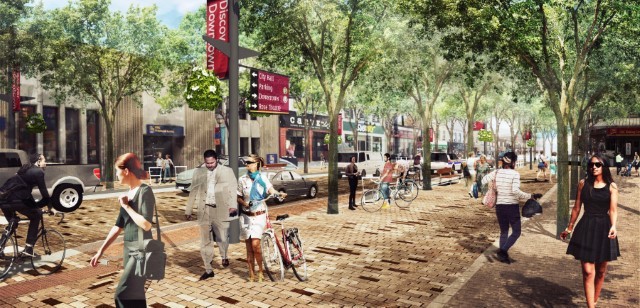
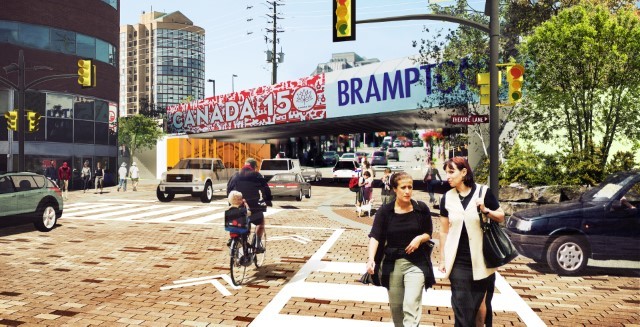
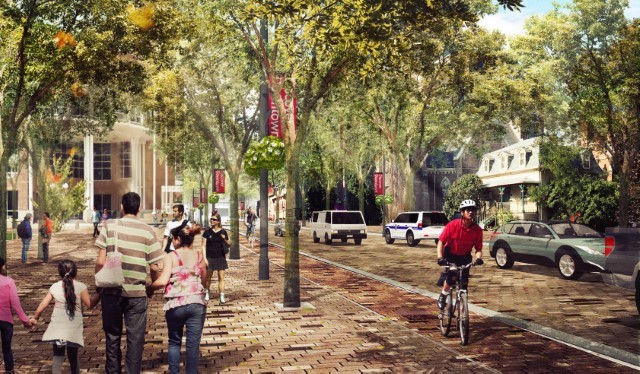
Renderings depict downtown Brampton after the completion of the Downtown Reimagined project. However, the joint project with the Region of Peel, which includes replacing critical infrastrucre beneath the city centre, has been put on hold, partially due to the unexpected cost.
In 2020, the city has budgeted $750,000 through its corporate asset management plan to try and improve the reliability of its infrastructure data through further studies.
There also remains one large question mark hanging over the 2020 budget process, and that is the potential implementation of a hospital levy to help pay the city’s share of Phase II of Peel Memorial.
Plans for a second fully functioning hospital are currently in the works. William Osler Health System, the organization that operates Brampton Civic Hospital and Peel Memorial Centre, is working on a proposal to submit to the province. The proposal would see plans to expand Peel Memorial Centre into a full service hospital. However, the proposal has not yet been submitted to the Ministry of Health, and there’s no deadline for when this will happen.
Dr. Naveed Mohammad, executive vice president of quality, medical and academic affairs at Osler, previously told The Pointer, the organization is in talks with the ministry about the expansion. The organization is taking its time with the proposal because it wants to make sure everything it needs is included, so problems don't arise in the short-term. If the proposal is submitted soon, it will likely be at least five years before doors open at the expanded Peel Memorial site.
A hospital levy would allow for funds to be collected specifically for the hospital, as was previously done to help pay for the first phase of Peel Memorial.
Previously, Mayor Brown said a hospital levy was a possible way forward. But Brampton could still fall short on funding, with the province asking for an approximately 25 percent contribution of the total cost, according to Brown. This includes 10 percent of the construction costs and 15 percent of other hospital necessities, such as equipment. “We can’t miss an opportunity for provincial funding. Hence why we are considering a hospital levy,” Brown previously said. While there is no hospital levy in the proposal at this time, things could change when presented to the budget committee this week.
Moving forward, the proposed 2020 budget will see extensive deliberations among councillors during a series of meetings with the first slated for Feb. 18, then again on Feb. 19 and 20. Additional meetings for deliberations are scheduled for Feb. 24 and 25 if necessary. If all goes to plan, the budget will be approved on Feb. 26 during a special meeting of council.
Residents will also get their chance to comment on the budget during a tele-town hall on Feb. 18 at 7 p.m. and during public delegations at the budget meeting at 7 p.m. on Feb. 19.
Email: [email protected]
Twitter: @JoeljWittnebel
Email: [email protected]
Twitter: @nida_zafar
Tel: 416-890-7643
Submit a correction about this story


